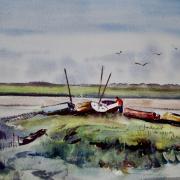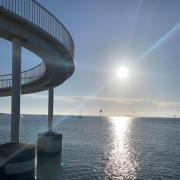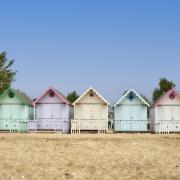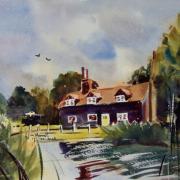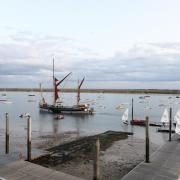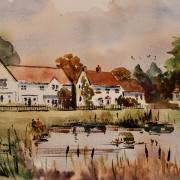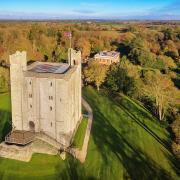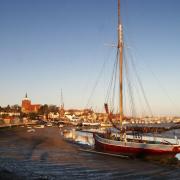‘O hear us when we cry to Thee, For those in peril on the sea’. These words come from the hymn ‘Eternal Father, Strong to Save’ (1860) which is traditionally associated with seafarers, especially in the maritime armed services, but also has resonance for those operating in the civilian marine including the brave personnel of the RNLI.
Lifeboats existed before the RNLI, the first purpose-built craft designed by Henry Greathead, and stationed at South Shields, in 1790. It was almost another 35 years before the National Institution for the Preservation of Life from Shipwreck was established by Sir William Hillary in March 1824. It was in 1854 that the charity’s name became the Royal National Lifeboat Institution (RNLI) and this year it celebrates its 200th anniversary.

The UK’s coastal communities, including Essex’s, know and respect the sea. In peacetime it provides pleasure and sustenance. During times of war it is our ‘moat defensive’ protecting us from foreign foe. During WW1, lifeboats were launched 1,808 times and saved 5,332 lives (1914-18). This heroism was repeated in WW2 when another 6,376 lives were saved (1939-45) and 19 RNLI lifeboats helped with the Dunkirk evacuation.
RNLI lifeboats are certainly no longer a male preserve. Elizabeth Horsvedt became the first woman qualified to command a lifeboat in 1969. The scale of today’s operation is staggering. RNLI volunteer lifeboat crews and lifeguards saved 506 lives in 2022 alone and helped 39,680 souls. Tragically, around 140 people still die annually in UK and Irish coastal waters and the RNLI’s vision is to save every single one of these. The RNLI works with communities and partners to try and prevent people getting into danger in the first place with males over 15 most at risk. It is certainly not just about the crew members who brave the waters, of whom only one in ten has a maritime profession, There are literally thousands of dedicated fundraisers and also volunteer shore crews who help with launching and recovering lifeboats. There are 238 lifeboat stations around the UK and Ireland covering 19,000 miles of coastline with 441 lifeboats (including relief fleet vessels) and seven hovercraft, whilst RNLI lifeguards patrol 240 UK and Channel Island beaches.

Essex is among the dozen or so areas of the UK that account for over half of accidental coastal deaths which focused my mind when I spoke to Simon Berry, coxswain of an all-weather lifeboat based at Walton and Frinton station which was founded in 1884. During the Pirate Radio era there were many callouts to the stations moored off the coast, and since 1902 Walton and Frinton RNLI crew members have been awarded four Silver medals and eleven Bronze medals. Simon and sister Miranda are direct descendants of the first station coxswain, Henry Britton (coxswain 1884-1914), whilst their father Jim also served at the station from 1958-1997 as both crew and station mechanic. Numerous other family members have been involved as coxswain, crew, launchers, shop volunteers and in fundraising. Simon has served at the station for 38 years as launcher, head launcher, crew mechanic and coxswain.
'Henry was on my Mum’s side. I met his grandson, Joe Britton, a Chelsea Pensioner, who remembered sitting on Henry’s knee and became a centenarian. My Dad moved here from Clacton when he was 12, but Mum lived here all her life and her mum before her. Lots of crew have longstanding associations with Essex and the RNLI. I’m self-employed, helping my Dad with yacht rigging. A lot of crew are self-employed as this makes responding to ‘shouts’ and fitting in training easier. We normally train Wednesday nights and Sunday mornings. Service calls obviously happen when they happen.

'I completed 38 years’ service in October. I began helping aged 14, although my recognised service didn’t commence until I was 17. The rough seas have never bothered me as I trust the boat to look after us. Yes, it can be uncomfortable and tiring but actual fear, no not really. We all understand risk assessment and we look after one another. We can be placed in ‘interesting’ situations, for example, being up to your knees in water on the deck of a foundering vessel, so that trust is important.
'We’re all volunteers. The mechanic is our only full-timer. What motivates us? There’s satisfaction, of course, and meeting really nice people from other walks of life I just wouldn’t have met otherwise. I once called a lifeboat out myself so have seen it from the other side. When children are involved in ‘shouts’ this pulls at the heartstrings. I’ve rescued children, normally with their parents/family. We instil confidence that it’s going to be OK. It’s about getting control of the situation early, taking the stress away, and stopping it snowballing, as people under stress can make bad decisions. We average around 25 calls a year. We have a Tamar Lifeboat for offshore and with lots of marinas and boats around we get more incidents during the boating season. There’s commercial stuff out there too. Storm Ciaran saw 60 mph winds, yet there was a yacht out there. You wonder what it was doing out in that forecast. The Harwich lifeboat helped that time. That kind of naivety is quite common. Dad did 38 years as crew and mechanic and it was the same in his day. We get all sorts; it’s the same at sea as on the motorway!

'We’re community oriented; most coastal stations are. There’s also strong family bonds. I recall an occasion when our seven-member crew included six directly related to one another which illustrates the close family bonds that exist. We have women crew members now and rightly so. Everyone has a role and ladies are invaluable when children and women are being rescued. Ability counts more than gender, after all, you wouldn’t tell Tracy Edwards and Ellen MacArthur they couldn’t be crew! We have people in there for their strengths, for example, a female paramedic. I’ve just turned 55, so I now have two-yearly medicals. I can theoretically carry on until 65 on an All-Weather boat, but we’ve had four 12 hour callouts this year and they take their toll. We operate in an isolated environment and it can be hours before can get in so the medicals are important. I’ll carry on as long as I feel I can or until the RNLI says otherwise.'
Simon’s sister, Miranda Rayner, is a self-employed personal trainer and Walton and Frinton’s Lifeboat Press Officer.

'It’s nice to serve with my brother and serve on the lifeboat, breaking new ground in the process. I’ve been crew for around 20 years out of my 33 years’ service in an operational role but my involvement with the RNLI goes back further, 46 years in fact. I’d joined the fundraising guild aged 10 and was in my 20s when I got the opportunity to become a launching team member in 1991, the first time we’d had a female at the station in any operational role. I’d sailed myself in various vessels and wanted to give back to the people who might have helped me. It’s important. We’re there to give families comfort and do what we can for those ashore. We also have to see the funny side of it sometimes; I was actually on the boat that assisted my brother.
'Our Dad had a boat so we went to sea and did everything. It was never a case of can you do it, but why wouldn’t you. Mum did her RYA sailing qualifications whilst Dad and Granddad ran fishing trips; it’s very much in the family. My step-granddad was a coxswain and ran fishing trips. So many members of our family have served in one capacity or another. My grandmother ran the shop at the station before I was born whilst Mum was a founder member of the fundraising branch committee so I was signed up. I was never forced but figured I would as everyone else did. Now, part of my role is to communicate the safety messages; the lessons learned for others’ benefit. Children are receptive and catching them young is vital. With children, the gorier the conversation, the more engaged they are! Each station has a visits officer who goes into schools. I mainly talk to adult groups although I’ve done a few talks in schools.

'I’ve been lucky. The RNLI provides the equipment to keep us safe. When I did my basic training though, the college at Poole didn’t exist, so I had to go to Norwich where they train people for the rigs. Most of our crew have some seagoing experience, but not everyone, which is where today’s great training comes in. Anyone can do it.'
There will be a programme of activities across all regions, including a special service of thanksgiving on the RNLI’s 200th birthday (4 March 2024). The cost of running the RNLI in 2022 was £188 million. 81p of every £1 raised funds lifesaving activities with the remaining 19p used to generate more funds.
rnli.org













